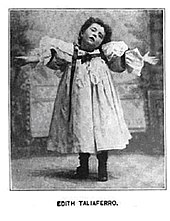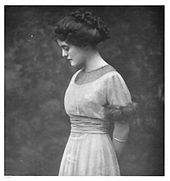Edith Taliaferro
Edith Taliaferro (December 21, 1894 – March 2, 1958) was an American stage and film actress of the late 19th and early 20th centuries. She was active on the stage until 1935 and had roles in three silent films. She is best known for portraying the role of Rebecca in the 1910 stage production of Rebecca of Sunnybrook Farm.
Edith Taliaferro | |
|---|---|
 | |
| Born | December 21, 1894 Richmond, Virginia, U.S. |
| Died | March 2, 1958 (aged 63) Newtown, Connecticut, U.S. |
| Nationality | American |
| Occupation | Actress |
| Years active | 1896–1935 |
| Spouse(s) | House B. Jameson ( m. 1912–1958) |
| Relatives | Mabel Taliaferro (sister) Bessie Barriscale (cousin) |
Early life and family
Taliaferro was born in Richmond, Virginia, the daughter of theatre workers.[1] She was the younger sister of Mabel Taliaferro who also became a stage actress, and the cousin of actress Bessie Barriscale.[2][3] Her ancestors were originally from England, of remote Italian descent (from the 1500s). They were one of the families who settled in Virginia in the 17th century.
Career
Early years

Taliaferro made her acting debut at the age of two in the stock stage production of Shore Acres, with James A. Herne.[1] It was rumored that she obtained the part because her sister Mabel was too old to depict the character. Her New York City debut came in 1896 at Miner's Theatre on Fifth Avenue in the same play. The Harlem Opera House presented Shore Acres in October 1897.
At the age of ten, in 1904, Taliaferro was paid $100 per week by George Tyler of Liebler & Company. She signed a contract for the following season to appear with Ezra Kendall. She was the youngest Shakesperean actress on the stage. She portrayed Puck in a Ben Greet production of A Midsummer Night's Dream before an audience at Princeton University in May 1904. She was lauded by professors there, and they sent her a Princeton University flag and pin. By then, she had performed in six to eight juvenile roles after her professional debut. When she returned to New York, Taliaferro appeared with Clara Bloodgood in The Girl with the Green Eyes. Early in her career, she toured with such stars as Olga Nethersole and E.H. Sothern.

In 1907, Frederic Thompson produced Polly of the Circus, written by Margaret Mayo, for his new wife Mabel Taliaferro, and at times during its run, Edith took on the lead roll of the youthful circus rider in her sister's place.[4] It ran for more than a year at the Liberty Theater, 242 West 42nd Street. The production moved to the Wieting Theater in Syracuse, New York in November 1908.
She is most noted for her 1910 performance in Rebecca of Sunnybrook Farm. It was staged at the Republic Theater (New Victory Theater), 209 West 42nd Street. Her other successful theatrical performances include roles in Young Wisdom (1914), Tipping The Winner (1914), A Breath of Old Virginia (1915), Mother Carey's Chickens (1917), and The Bestsellers (1918).
Films, later career and retirement

Taliaferro made her silent film debut in Young Romance in 1915. She made only two more films, The Conquest of Canaan (1916) and Who's Your Brother? (1919). She returned to Broadway in 1919 in Please Get Married followed by roles in Kissing Time (1920), A Love Scandal (1923), and as "Amanda Prynne" in the touring company production of Private Lives in 1931.[5] She performed in London, England and in Australia with the Toronto Theatre Guild. In vaudeville she appeared at the Palace Theater in New York City. Most of her later work was with summer theaters and on radio. Taliaferro retired from stage work in the late 1930s after she lost her vision.[6]
Personal life
Taliaferro's first husband was actor Earl Browne. The marriage was announced in July 1913.[7] Taliaferro's second husband was actor House B. Jameson, whom she married around 1928.[8] Jameson appeared in various stage productions and later became known for his role as Sam "Papa" Aldrich on the radio and television series The Aldrich Family.[9] The couple had no children and remained married until Taliaferro's death.[10]
Death
On March 2, 1958, Edith Taliaferro died of an undisclosed illness at her home in Newtown, Connecticut.[10]
Stage credits
| Date | Production | Role |
|---|---|---|
| 1896 | Shore Acres | Millie Berry |
| March 26 – April 1900 | The Sunken Bell | |
| September 23 – November 1901 | The Bonnie Brier Bush | |
| December 25, 1902 – Closing date unknown | The Girl with the Green Eyes | Susie |
| 1904 | Uncle Tom's Cabin | Little Eva |
| September 17 – October 1906 | Mrs. Wiggs of the Cabbage Patch | Lovey Mary |
| September 30 – October 1907 | The Evangelist | Ione Nuneham |
| October 3, 1910 – April 1911 | Rebecca of Sunnybrook Farm | Rebecca |
| January 5 – March 1914 | Young Wisdom | Gail Claffenden |
| September 23 – October 1914 | Tipping the Winner | Dorothy Gay |
| 1915 | A Breath of Old Virginia | Mary Davis |
| November 13, 1916 – March 1917 | Captain Kidd, Jr. | Mary MacTavish |
| September 25 – October 1917 | Mother Carey's Chickens | Nancy Carey |
| June 1918 | The Best Sellers | |
| June 10–29, 1918 | Muggins | |
| February 10, 1919 – Closing date unknown | Please Get Married | Muriel Ashley |
| October 11 – December 4, 1920 | Kissing Time | Clarice |
| July 18–28, 1924 | Fashions of 1924 | Neil Barton |
| November 17 - December 1923 | A Love Scandal | Bettina Tilton |
| 1931 | Private Lives | Amanda Prynne |
| May 7 - May 1935 | The Hook-up | Mary Bainbridge |
Filmography
| Year | Title | Role | Notes |
|---|---|---|---|
| 1915 | Young Romance | Nellie Nolan | |
| 1916 | The Conquest of Canaan | Ariel Tabor | |
| 1919 | Who's Your Brother? | Esther Field | Alternative title: Keep [It] to the Right.[11] |
References
- "Theater Talk". Mansfield News. April 16, 1909. p. 7.
- "Theatres". The New York Times. October 10, 1897. p. 5.
- "Ten Years Old; $100 A Week". The New York Times. May 24, 1904. p. 9.
- "Edith Taliaferro Of Stage, Was 64". The New York Times. March 3, 1958. p. 27.
- "Wieting-Polly of the Circus". Syracuse Herald-Journal. November 15, 1908. p. 30.
Footnotes
- Fisher, James; Hardison Londre, Felicia (2009). The A to Z of American Theater: Modernism. Rowman & Littlefield. p. 465. ISBN 978-0-810-86884-7.
- Hischak, Thomas S. (2003). Enter the Players: New York Stage Actors in the Twentieth Century. Scarecrow Press. p. 304. ISBN 0-810-84761-2.
- Lowe, Denise (2014). An Encyclopedic Dictionary of Women in Early American Films: 1895-1930. Routledge. p. 1865. ISBN 978-1-317-71896-3.
- Munsey's Magazine - Volume 39 - 1908, Page 846
- Gaines, William (July 20, 1931). "Sidelights In New York". Gettysburg Times. p. 6.
- ""Rebecca" Dies". The Spokesman-Review. March 2, 1958. p. 15.
- "19 Jul 1913, Page 3 - The Rock Island Argus and Daily Union at Newspapers.com". Retrieved August 6, 2016.
- Wolters, Larry (March 14, 1953). "Father Aldrich In Harem Class; Has 4 TV Wives".
- Oliver, Wayne (January 25, 1953). "The Lone Ranger Gallops Into Third Decade This Week". The News and Courier. p. 10–D.
- "Edith Taliaferro". Daytona Beach Morning Journal. March 3, 1958. p. 3.
- See photograph at http://www.shorpy.com/node/13082 which omits "It"
External links
| Wikimedia Commons has media related to Edith Taliaferro. |